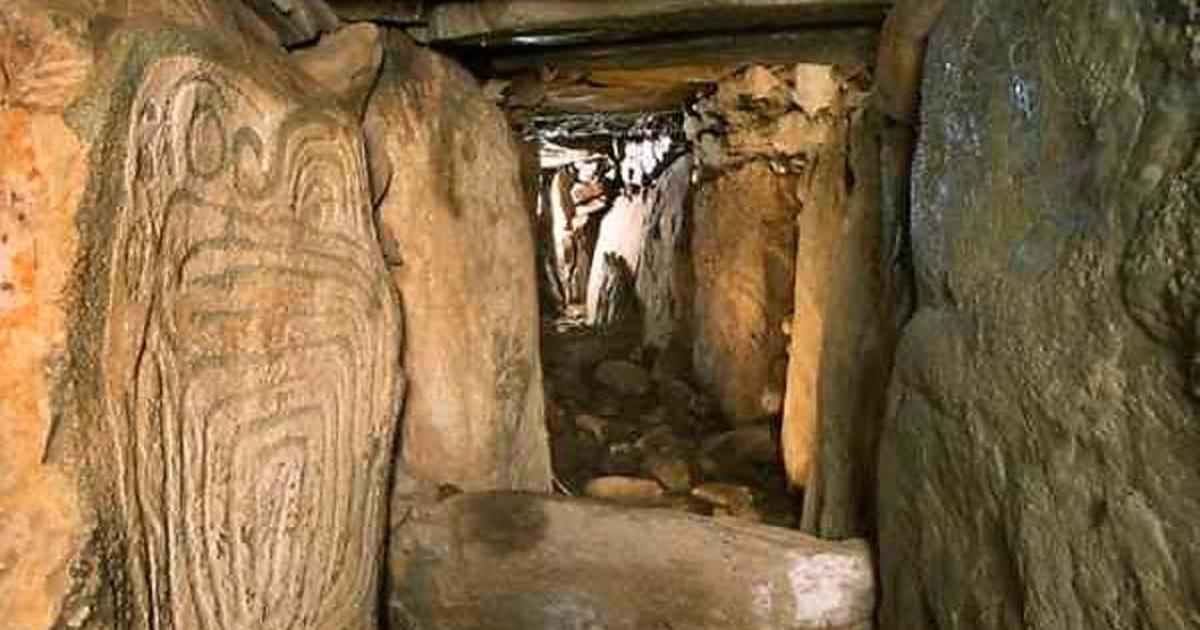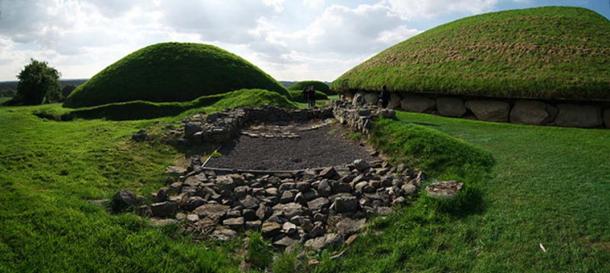
Mystifying Megaliths: Knowth, Keeper of Ancient Tombs
The rolling green hills outside of Ireland hold more history than can be seen. Legend blends into folklore, and folklore transforms into history. Knowth, located not far from Dublin, is part of a greater pre-Christian complex called Brú na Bóinne, within which Knowth is joined by sister sites Newgrange and Dowth. From its mythological founding to the mysterious mortal builders of its megalithic passage tombs, Knowth has withstood the tests of both time and bloodshed as bravely as Tara, the hill of Ireland's ancient and medieval sovereignty. Knowth therefore rivals Tara not only as a stronghold of Irish power, but as keeper of the best preserved megalithic tombs of the region.
Knowth’s Megalithic Tombs
The megalithic passage tombs at Knowth (and at the neighboring Newgrange and Dowth) were manmade, created from large megalithic stones. Evidence suggests that these structures were intentionally forged for pre-Christian burial and ritual purposes. Around 2000 years later, after a gap in activity, it appears that the site was used for a few select Iron Age cist graves—thus Knowth's sacredness was either remembered and expanded or inadvertently continued after the millennia break.

Knowth panorama. (Günter Claßen/CC BY SA 3.0)
The particulars regarding the structure of the tombs are best described by Ireland's own world heritage site:
"[Knowth] covers about half a hectare (approx. 1.5acre) and is 95m across at its widest point. Around the entrances to the tombs are settings of unusual stones such as quartz, granite and banded stones. Smaller tombs, some of which are connected to the large tomb, cluster around the great mound."
- Exploring the Mysterious Megaliths of the Bada Valley in Indonesia
- Evidence of Ancient Megalithic Culture in Massachusetts Revealed For the First Time
- Major Discovery: 4,500-year-old megalithic super-henge found buried one mile from Stonehenge

Aerial view of Knowth. (Dept. Environment, Heritage & Local Government)
Knowth encompasses two megalithic tombs, known simply to modern archaeologists as the east and west tombs. Megalithic tombs are precisely what they sound like—a large chamber lies at the end of a long, sometimes curving, passage. The chamber itself is not only wide enough for more than one visitor, but also tall enough for visitors to stand erect. Beehive ceilings shaped by corbelling allow visitors extra standing room, likely for the purpose of whatever religious rites were performed within the mounds.

Eastern Passage inside the megalithic site of Knowth, Co. Meath, Ireland. (Przemysław Sakrajda/CC BY SA 3.0)
Mythical Inhabitants at Knowth
Mounds were sacred sites in numerous ancient cultures, particularly those located in the British Isles, and it is believed that it is from these religious traditions that the medieval beliefs of fairy mounds stemmed. Mythologically, Knowth has a long-standing role in pre-Christian traditions. Irish folklore tells the tale of Oengus (or Aengus), the son of the Dagda and thus one of the Tuatha de Danann, who requested the area of Brú na Bóinne (thus Newgrange, Dowth and Knowth) as his personal abode.
Legend states at he fell in love with a mortal princess named Caer Ibormeith (cursed in the form of a swan yearly) in his dreams, and ventured away from Brú na Bóinne to find her. After successfully locating her amongst numerous swans, Oengus and Caer lived the rest of their days happily married within Brú na Bóinne.
A painting of a Victorian era description of Áengus mac Óg, depicted here with swan wings. (Public Domain)
Knowth’s Art and Archaeology
Archaeological evidence reveals that the megalithic tombs very likely were locations of religious rituals; yet whether those rituals involved burial alone or other practices is still up for debate. Little evidence has been found to suggest habitation in or around the mound in the Neolithic period; yet the discoveries of votive offerings both within and outside the megalithic structure indicate the likelihood of visitors to the site for religious reasons. Archaeologists have postulated that due to the construction of the passages within the mound—and similar structures seen at Tara, for example—there was likely an astronomical reason behind the methods used and the erection of the megalithic structures. The procession of ritual activities in, around, and/or through Knowth likely had a relationship between the east-west movement of the sun and the corresponding gods.
Artistically, Knowth contains a vast amount of megalithic artwork, ranging from the "typical" ancient Celtic symbols of spirals and lozenges (diamond or rhombus shapes), both usually believed to represent the cycle of the sun or seasons. Once more, due to these pre-Christian geometric patterns—ones that have been frequently uncovered in pagan Celtic spaces—a correlation between the movement of the sun and the use of the mound seems likely. The ogham writing of the early Irish people also abounds on the megaliths, though these writings are from about two thousand years after the geometric shapes were likely carved. Not only do these inscriptions reveal the site was returned to and once again valued, but it was between the period of spirals and lozenges and the ogham writings (the Neolithic period and early Iron Age, respectively) that Knowth went through its most significant transformation.

Megalithic carved stone at Knowth featuring a series of incised spiral markings. (John M/CC BY SA 2.0)
During the Neolithic period, Knowth was almost certainly strictly a religious burial site that was eventually abandoned. Reasons for its abandonment are uncertain; the lack of habitual items found dating to the 2000-year gap between the Neolithic period and the Iron Age is the predominate indicator of this abandonment.
- Incredible Megaliths of India: Star Maps and Headless Goddesses – Part I
- Megalithic Origins: Göbekli Tepe and Ancient Peru - The Same Architects?
- 6,000-year-old cremated remains discovered in megalithic tomb in Ireland
With the approach of the end of the Iron Age, however, and the beginnings of the new Christian era, people returned to Knowth, albeit without prior knowledge of the site's use (it is believed). As Knowth was transformed from a sacred mound of megalithic burial chambers to a fortified hill fort, the people of the late Iron Age rediscovered the aforementioned passage graves. It does not appear that the newcomers used the megalithic graves for their own burial purposes, but rather chose to bury a select few of their dead nearby in the aforementioned cist graves. The prominence of the megalithic tombs in later habitations becomes more and more evident due to the collection of Christian carvings found within the passages, and the medieval ogham inscriptions.

Foundations of a later (Christian?) building, long post-dating the construction of Knowth’s Passage Tomb Cemetery. The main mound is visible at right, with a satellite tomb to the left. (Rob Hurson/CC BY SA 4.0)
Today, Knowth is protected by the World Heritage Association of Ireland, along with her sister sites Newgrange and Dowth. Under the association, people can visit the locations and explore the passage graves in a way meant to protect both the visitors and the sites themselves. During the Iron Age, parts of the Knowth megalithic passage tombs suffered damage during the construction of the hill fort and the World Heritage Association seeks to prevent further damage, whether accidental or incidental. Though Knowth is no longer utilized for ritual or burial purposes in the present, its rich history can be consistently revisited.
Top Image: Western passage at the megalithic site of Knowth with decorated orthostat on left. Co. Meath, Ireland. Source: Dept. Environment, Heritage & Local Government
Bibliography
Best, R., O'Brien, M. and Bergin, O. 1954. The Book of Leinster. Dublin: Dublin Institute for Advanced Studies.
Binford, L.R. 1982. The Archaeology of Place. Journal of Anthropological Archaeology 1:, pp. 5–31.
Dept. of Environment, Heritage & Local Government. 2010. "Brú na Bóinne." Worth Heritage Ireland. Accessed September 19, 2017. http://www.worldheritageireland.ie/bru-na-boinne/
Dept. of Environment, Heritage & Local Government. 2010. "Knowth." Worth Heritage Ireland. Accessed September 19, 2017. http://www.worldheritageireland.ie/bru-na-boinne/built-heritage/knowth/
Duffey, S., 2005. Medieval Ireland: An Encyclopedia, New York City: Routledge.
Keating, G. 2008. Foras feasa ar Éirinn = The history of Ireland.. Comyn, D. (ed.) archive.org. Available at: https://archive.org/details/forasfeasaarir06keatuoft [Accessed January 23, 2016].
Laing, Lloyd and Jennifer Laing. 1996. Art of the Celts. London: Thames & Hudson, Ltd.
MacAirt, Sean and Gearoid mac Niocaill. (eds.) 1983. The Annals of Ulster (to A.D. 1131). Dublin: Dublin Institute for Advanced Studies.
Macalister, R.A.S. 2012. Lebor gabála Érenn : The book of the taking of Ireland. Great Britain: Ulan Press.
MacCulloch, J.A. 2009. The Religion of the Ancient Celts. Auckland: The Floating Press.
Oubina, C.P., Boado, F.C. & Estevez, M.S., 1998. "Rewriting Landscape: Incorporating Sacred Landscapes into Cultural Traditions." World Archaeology, 30(1), pp.159–176.
Schramm, K., 2011. Introduction Landscapes of Violence: Memory and Sacred Space. History and Memory, 23(1), pp.5–22.
Waddell, J., 2011. "Continuity, cult and contest." In R. Schot, C. Newman, & E. Bhreathnach, eds. Landscapes of Cult and Kingship. Dublin: Four Courts Press, pp. 192–212. Available at: http://hdl.handle.net/10379/2075.















